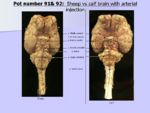Difference between revisions of "CNS Vasculature - Anatomy & Physiology"
| Line 25: | Line 25: | ||
*Basiliar artery | *Basiliar artery | ||
*The anastomosing ramus from the maxillary artery to the internal carotid artery | *The anastomosing ramus from the maxillary artery to the internal carotid artery | ||
| − | *The connection of the | + | *The connection of the vertebral artery to the internal carotid artery |
| − | |||
| − | |||
| + | ===Dog and Man (and many other species)=== | ||
[[Image:Calfvssheepblood.jpg|thumb|right|150px|Calf vs Sheep blood supply comparism. RVC 2008]] | [[Image:Calfvssheepblood.jpg|thumb|right|150px|Calf vs Sheep blood supply comparism. RVC 2008]] | ||
| − | + | Channels 1 and 2 supply the arterial circle. Neither channel has a [[#Rete_Mirable|rete mirable]]. The internal carotid artery blood reaches all of the cerebral hemisphere except for it's most caudal part. Vertebral blood supplies the the remainder of the cerebral hemisphere and the rest of the brain. | |
| − | + | <br /> | |
| − | + | ===Sheep and Cat=== | |
| − | + | Only channel 3 supplies the arterial circle and unlike in the dog, this channel has a rete mirable. Channel 2 carries blood away from the arterial circle. Maxillary blood is distributed to all of the brain except the caudal part of medulla oblongata, which is supplied by vertibral blood. | |
| − | + | <br /> | |
| − | + | ===Ox=== | |
| − | + | Channels 3 and 4 both supply the arterial circle and each has a rete mirable. Channel 2 carries blood away from the arterial circle. A mixture of maxillary and vertebral blood reaches all parts of the brain. | |
| − | |||
| − | |||
| − | |||
| − | |||
| − | |||
| − | |||
| − | |||
| − | |||
| − | |||
| − | |||
| − | |||
| − | |||
[[Category:Nervous_System_-_Anatomy_&_Physiology]] [[Category:To_Do_-_A&P]] | [[Category:Nervous_System_-_Anatomy_&_Physiology]] [[Category:To_Do_-_A&P]] | ||
Revision as of 16:54, 5 March 2011
Circle of Willis
Blood is supplied to the brain by the internal carotid artery in dogs and horses whilst in other domestic species the main blood supply is from branches of the maxillary artery. The Circle of Willis (also called the cerebral arterial circle or arterial circle of Willis) is a circle of arteries that supply blood to the brain. The Circle of Willis is made up of the following arteries;
- Left and right inferior cerebral arteries
- Anterior communicating artery
- Left and right internal carotid arteries
- Left and right posterior cerebral arteries
- Left and right posterior communicating arteries
The arrangement of the Circle of Willis means that if one part of the circle becomes blocked or narrowed (stenosed), or one of the arteries supplying the circle is stenosed, blood flow from the other blood vessels can continue to provide a continuous supply of blood to the brain.
Note: The basilar artery and middle cerebral arteries, though they supply the brain, are not considered part of the circle.
Rete Mirable
The Rete Mirabile is a complex network of arteries and veins lying very close to each other and depends on a countercurrent blood flow between the arterioles and venuoles (blood flowing in opposite directions). It exchanges heat, ions, or gases between vessel walls so that the two bloodstreams within the rete maintain a gradient. The image shows the countercurrent exchange in the carotid rete mirable (carotid rete) of a sheep controlling the temperature of blood supplied to the brain.
Species Differences
The blood supply to the brain has major differences depending on species. Across all species, there are four 4 potential channels to facilitate blood supply to the Circle of Willis. These are;
- Internal carotid artery
- Basiliar artery
- The anastomosing ramus from the maxillary artery to the internal carotid artery
- The connection of the vertebral artery to the internal carotid artery
Dog and Man (and many other species)
Channels 1 and 2 supply the arterial circle. Neither channel has a rete mirable. The internal carotid artery blood reaches all of the cerebral hemisphere except for it's most caudal part. Vertebral blood supplies the the remainder of the cerebral hemisphere and the rest of the brain.
Sheep and Cat
Only channel 3 supplies the arterial circle and unlike in the dog, this channel has a rete mirable. Channel 2 carries blood away from the arterial circle. Maxillary blood is distributed to all of the brain except the caudal part of medulla oblongata, which is supplied by vertibral blood.
Ox
Channels 3 and 4 both supply the arterial circle and each has a rete mirable. Channel 2 carries blood away from the arterial circle. A mixture of maxillary and vertebral blood reaches all parts of the brain.

